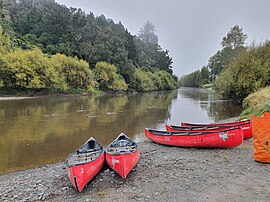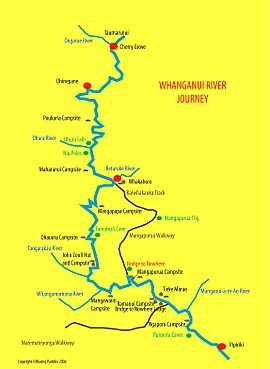|
Whanganui Journey
The Whanganui Journey is a river journey along the Whanganui River in the North Island of New Zealand, travelling by canoe or kayak. The route runs from Taumarunui to Pipiriki, is 145 km long and usually takes 5 days to complete. It is managed by New Zealand's Department of Conservation under its Great Walks programme, and much of the route travels through land that is part of the Whanganui National Park. Route descriptionThe route is broken into sections that are stretches of river between campsites or huts.
During normal weather conditions the rapids on the river will not exceed grade II. As a result, there are several tour operators that offer a variety of trip combinations covering all or part of the route. Although the Great Walk route ends at Pipiriki, the river is navigable for a further 89 km and some canoeists continue, to exit at the main bridge in Whanganui, which takes a further two days. Because the river is tidal closer to Whanganui, canoeists doing so need to leave Hipango Park on an outgoing tide. Accommodation Accommodation on the route is in a combination of huts and campsites, which must be booked. River users must purchased a Facilities User Pass (FUP) if travelling on the river between 1 October and 30 April. It is cheaper to purchase the FUP before going on the river. They are available from the various operators, DOC in Whanganui, or from local Visitor Information Centres. There are different rates for different age groups, and for jetboaters. Most tour operators/canoe hire places will organize camp sites when travellers book with them, and they supply all safety equipment, a map, and transport to/from either end. References
External links |
||||||||||||||||||||||||||||||

